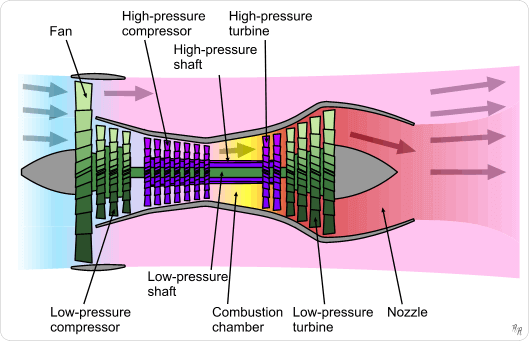Nano twins are not something Robin Williams’ Mork would make friends with. They are destructive pairings inside alloys, and getting rid of them will apparently lead to cleaner jet flight. Ohio State University researchers devised a technique they call “Phase Transformation Strengthening” which leads to stronger alloys and less deformation of the final products. This is good news for jet engine and turbine designers, since an engine that can run hotter will burn its fuel more completely, resulting in a less toxic exhaust. Nano twins “are microscopic defects that grow inside alloys and weaken them,” according to Ohio State University researchers. These defects weaken and deform an alloy when it is exposed to heat and pressure – two things present in a jet engine or power turbine. Michael Mills, professor of materials science and engineering and leader of the project at Ohio State, led the research. “We found that increasing the concentrations of certain elements in super-alloys inhibits the formation …
Batteries That Heal Themselves
Alert reader Colin Rush provided this breaking development in battery science. Regular readers will remember Dr. Yi Cui’s name. He’s a Stanford University scientist who has worked with paper batteries, much more powerful electrodes, and means of helping batteries stay together under the continuous strain of expanding and contracting during charging and discharging. He explained that at the third annual Electric Aircraft Symposium at the Hiller Aviation Museum, and has since adopted several tactics to overcome that problem. One commercial outgrowth of his work, Amprius, is working on commercial production that benefits from his insights. Since that internal flexing eventually leads to cracking of electrodes, Dr. Cui’s latest announcement brings some hope that such things can not only be overcome, but literally healed. Just as our bodies have internal resources to fight diseases and repair muscle and bone, batteries can be made to be self-healing. Dr. Cui has been a proponent of using silicon as a major component in electrodes, …
Peel-and-Stick Solar Cells Make Debut
The U. S. Department of Energy’s National Renewable Energy Laboratory (NREL) and Stanford University have teamed up to create what may be the thinnest of thin solar cells – a peel-and-stick decal. One micron thick, the decal-like peel-and-stick, or water-assisted transfer printing (WTP), technologies were developed by Stanford researchers and have been used for nanowire based electronics. Meeting at a conference where both made presentations, Stanford’s Xiaolin Zheng talked about her peel-and-stick technology, and NREL principal scientist Qi Wang spoke on his team’s research in thin-film amorphous solar cells. Zheng realized that the NREL had the type of solar cells needed for her peel-and-stick project, according to the NREL announcement. The NREL press release explains, “The university and NREL showed that thin-film solar cells less than one-micron thick can be removed from a silicon substrate used for fabrication by dipping them in water at room temperature. Then, after exposure to heat of about 90°C for a few seconds, they can …
Nanowire Solar Cells Surprise and Excite
Long-time friend of the blog, and occasional corrector of the editor’s attempts at incorporating French into the proceedings, Colin Rush sent this link to a story about photonics in the Christian Science Monitor. “Wires 1/10,000th the diameter of a human hair can absorb more of the sun’s power than previously thought possible, a new study in Nature Photonics suggests,” writes David Unger, an energy correspondent for the Monitor. Unger’s lead paragraphs pushed your editor to look up several related terms and look further into the researchers’ own writing. “Although still years away from production, nanowire solar cells could push the conversion efficiency of the sun’s energy past the so-called Shockley-Queisser limit, which for decades has served as a fixed ceiling in solar energy research. “Such a breakthrough would be significant because the sun’s power is wildly abundant, but diffuse, and difficult to harvest. Even increasing the limit by a few percent would go a long way in making solar a more viable alternative to …
There’s Light at the End of the Funnel
Solar cells are relatively inefficient at gathering the total range of sunlight’s spectrum that falls on them every day. Trying to find a way to capture more than a single wavelength or narrow band of the solar light, scientists at Massachusetts Institute of Technology (MIT) and at Peking University in China propose putting a strain on solar cells, creating a spatially varying bandgap that would react to more of the colors in light and thus give off more electricity. Changing the bandgap in a solar collector’s material enables excitation of electrons from not just visible light, but from energy sources such as infrared radiation. This has the potential to increase the cell’s energy output enormously since most of the sun’s radiation is in invisible form. Bandgap is a complex concept, and MIT provides a brief tutorial here. MIT’s news office reports: “’We’re trying to use elastic strains to produce unprecedented properties,’ says Ju Li, an MIT professor and corresponding …

